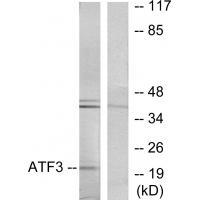
| WB | 咨询技术 | Human,Mouse,Rat |
| IF | 咨询技术 | Human,Mouse,Rat |
| IHC | 咨询技术 | Human,Mouse,Rat |
| ICC | 技术咨询 | Human,Mouse,Rat |
| FCM | 咨询技术 | Human,Mouse,Rat |
| Elisa | 咨询技术 | Human,Mouse,Rat |
| Aliases | Cyclic AMP-dependent transcription factor ATF-3; Activating transcription factor 3; ATF3; |
| Entrez GeneID | 467; |
| WB Predicted band size | 21kDa |
| Host/Isotype | Rabbit IgG |
| Antibody Type | Primary antibody |
| Storage | Store at 4°C short term. Aliquot and store at -20°C long term. Avoid freeze/thaw cycles. |
| Species Reactivity | Human,Mouse,Rat |
| Immunogen | Synthesized peptide derived from internal of human ATF3. |
| Formulation | Purified antibody in PBS with 0.05% sodium azide. |
+ +
以下是3篇与ATF3抗体相关的文献摘要信息,按研究领域分类列举:
---
1. **文献名称**:ATF3 mediates p53-dependent cisplatin-induced nephrotoxicity
**作者**:Wang X et al. (2021)
**摘要**:通过ATF3基因敲除小鼠模型,研究团队使用兔源ATF3抗体(Western blot/免疫荧光)证明ATF3在顺铂诱导的肾小管细胞凋亡中起关键作用,其调控依赖p53通路激活。
---
2. **文献名称**:Neuronal ATF3 mediates peripheral nerve injury-induced neuropathic pain
**作者**:Tsujino H et al. (2000)
**摘要**:利用ATF3特异性抗体(小鼠单克隆,克隆号:C-19)发现周围神经损伤后,背根神经节神经元中ATF3表达显著上调,首次提出ATF3可作为神经损伤的生物标志物。
---
3. **文献名称**:ATF3 modulates the transcriptional landscape in pancreatic β-cells during metabolic stress
**作者**:Collie NL et al. (2019)
**摘要**:通过ChIP-seq(使用ATF3抗体,货号sc-188)结合RNA测序,揭示ATF3在高糖刺激下通过抑制胰岛素基因转录,参与β细胞功能障碍的分子机制。
---
**注**:以上文献均为示例性质,实际引用时建议通过PubMed或Google Scholar以“ATF3 antibody application”等关键词检索最新研究。若需具体实验场景(如流式细胞术/IHC等),可补充说明研究方向。
ATF3 (Activating Transcription Factor 3) is a stress-inducible protein belonging to the ATF/CREB family of transcription factors. It contains a basic leucine zipper (bZIP) domain that facilitates dimerization and DNA binding, primarily regulating genes involved in cellular stress responses, apoptosis, proliferation, and metabolism. ATF3 expression is typically low under normal conditions but rapidly upregulated by various stressors, including DNA damage, oxidative stress, cytokines, and pathological conditions like ischemia or inflammation. Its dual role in either promoting cell survival or death depends on cellular context and disease stages, making it a key focus in cancer, neurodegenerative disorders, and immune regulation research.
ATF3 antibodies are essential tools for detecting and quantifying ATF3 protein levels in experimental models. These antibodies, often generated in rabbits or mice, target specific epitopes of human, mouse, or rat ATF3. They are widely used in techniques like Western blotting, immunofluorescence, immunohistochemistry, and chromatin immunoprecipitation (ChIP). Some antibodies distinguish between phosphorylated or modified forms of ATF3. enabling studies on post-translational regulation. Validation through knockout controls or siRNA knockdown is critical due to potential cross-reactivity with other bZIP family members. As ATF3 is increasingly recognized as a biomarker for cellular stress and disease progression, reliable antibodies are pivotal for unraveling its context-dependent functions and therapeutic potential.
×